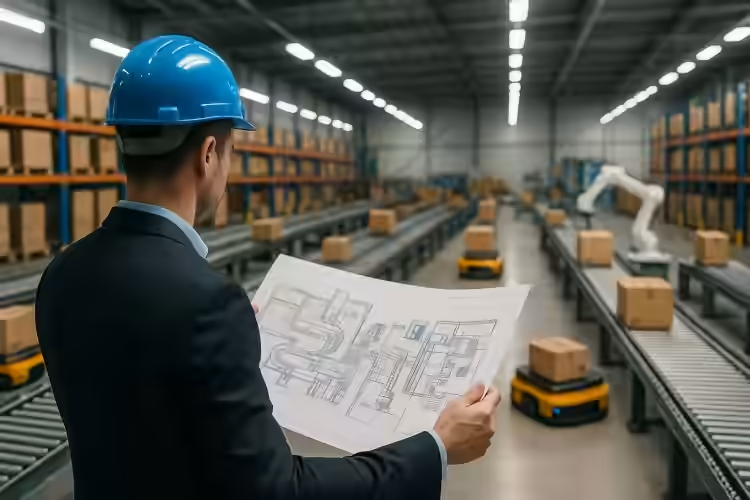Why Plan for Automation Now?
If you’re thinking, “we’ll automate when we grow bigger,” you’re not alone—but you’re also not thinking far enough ahead.
Automation is no longer some futuristic concept reserved for Amazon or Tesla. Smaller 3PLs, regional distributors, and even mom-and-pop e-commerce brands are installing everything from conveyor belts to autonomous forklifts. Why? Because labor’s expensive and getting harder to find. Efficiency isn’t optional—it’s survival.
In places like Riverside, California or Allentown, Pennsylvania, we’re seeing tenants ask for automation-ready facilities before they hit scale. They don’t want to retrofit later—they want to be ready to plug and play.
Designing with Automation in Mind
Okay, you’re convinced automation matters. So how do you plan your space?
Let’s start with one word: flow.
Whether you're thinking about robotic pickers, AGVs (automated guided vehicles), or smart racking systems, automation needs space to move—and move efficiently.
Key factors to consider:
Clear heights: Anything under 24’ might be limiting long-term. 32’+ is ideal.
Column spacing: 50x50 is decent. Wider is better. Columns cramp robotics.
Dock doors: More doors = more loading zones = better throughput.
Floor loads: Robotics and vertical lifts are heavy. Make sure your slab can take it (typically 6” reinforced concrete at a minimum).
Aisle width: Narrow is good for dense storage, but too narrow kills AGV efficiency. You’ll want flexibility here.
It’s not about filling every inch. It's about creating a clean, navigable environment for both machines and people.
Power, Connectivity & Infrastructure Requirements
Robots don’t run on dreams—they run on power and data.
Here’s what to think about:
Amperage: 200 amps might work for basic lights and fans, but add in battery chargers, automation equipment, and server racks? You’ll need more—often 400A or 600A, especially if you're adding HVAC.
Battery charging stations: AGVs and electric forklifts eat up space and power. Plan a dedicated charging zone near docks.
Wi-Fi and hardwired networking: Automation runs on connectivity. Weak signals mean dropped data, stalled robots, and expensive downtime.
Server rooms: If you're deploying WMS (warehouse management systems) or real-time tracking, carve out space for climate-controlled data storage.
Redundancy: Backup generators or at least battery backups can save you during outages.
And don’t forget to ask the landlord: who handles electrical upgrades? Some older buildings—especially in Michigan or Ohio—are underpowered and costly to retrofit.
Think Modular: Start Small, Scale Smart
You don’t need to drop seven figures to get into automation. Not even close.
Start with modular tech:
A few autonomous mobile robots (AMRs) to shuttle goods.
Barcode scanning paired with handheld tablets.
Sensor-equipped racking to track SKU levels.
Then, scale.
The beauty of modular systems is you can grow as your needs do. Think of it like Lego blocks—stack, reconfigure, expand.
Case in point: a regional shipper in Dallas, Texas started with just one picking robot and three smart carts. Within two years, they had fully automated their inbound sorting area—all without changing buildings.
Moral of the story? Build flexibility into your plan from day one.
Don’t Forget the Human Factor
Here’s the funny thing about automation: it doesn’t eliminate humans—it makes their work better.
But only if you plan for it.
Key people-planning steps:
Retraining: Upskill warehouse workers to operate and maintain automation.
Safety zones: Separate robot lanes from human foot traffic with clear striping, bollards, or even light curtains.
Break and recharge spaces: All that efficiency means faster paces. Your team still needs safe, comfortable rest areas.
And let’s be real—automation without buy-in can tank morale. Bring in your team early. Let them test new tools. You’d be surprised how quickly a skeptical forklift driver becomes a robotics advocate after a week of working smarter, not harder.
What to Ask When Leasing Automated-Ready Warehouses
Most warehouses weren’t built for automation—so finding one that is takes a sharper set of questions.
Ask these when scouting industrial space:
What’s the current power capacity? Can it be expanded?
Can we trench the floor or install cabling?
Is there permission for structural modifications like ceiling-mounted tracks or catwalks?
Are there pre-installed conduit paths for data and sensors?
How long does the landlord take to approve tenant improvements (TI)?
In emerging logistics hubs like Nashville, Tennessee or Salt Lake City, Utah, some new builds come pre-marketed as “automation-ready.” But read the fine print. A slick brochure doesn’t guarantee trenchable floors or panel space for new breakers.
Common Mistakes That Kill ROI
Let’s talk about what not to do.
Overbuying hardware too soon. Buying 10 robots when you need 3? That’s not strategic—it’s wasteful.
Ignoring change management. Automation fails when the people using it don’t trust it—or don’t know how to.
Siloed planning. Your automation vendor, warehouse manager, and leasing agent need to talk. Period.
Neglecting maintenance plans. These machines aren’t set-and-forget. Budget for service contracts and backup parts.
Assuming everything integrates. Your new robot fleet might not talk to your old WMS unless you plan for middleware or software bridges.
Bottom Line: It’s About Flexibility, Not Flash
Warehouse automation isn’t about looking futuristic—it’s about building an operation that can flex with demand, cut waste, and boost uptime.
So don’t focus on buying the coolest robots. Focus on:
Designing a space that flows.
Equipping it with scalable infrastructure.
Training your team to grow with the tech.
Because five years from now, the warehouses that win won't just be automated. They’ll be adaptable.
And that starts with a plan, not a purchase.

